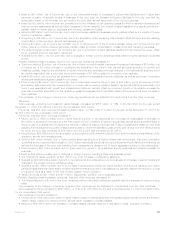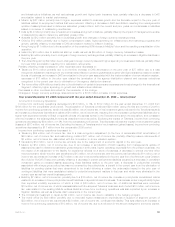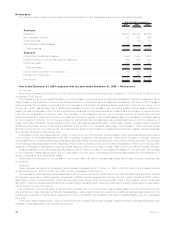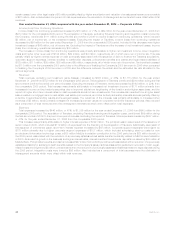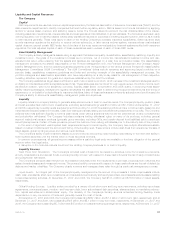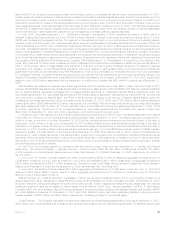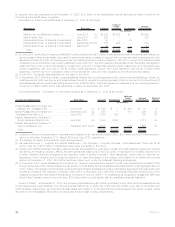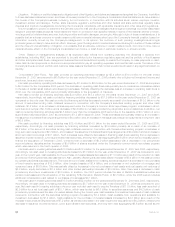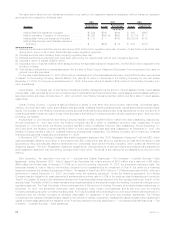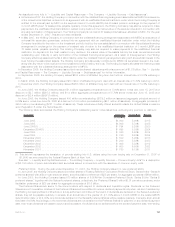MetLife 2007 Annual Report Download - page 47
Download and view the complete annual report
Please find page 47 of the 2007 MetLife annual report below. You can navigate through the pages in the report by either clicking on the pages listed below, or by using the keyword search tool below to find specific information within the annual report.Liquidity and Capital Resources
The Company
Capital
RBC requirements are used as minimum capital requirements by the National Association of Insurance Commissioners (“NAIC”) and the
state insurance departments to identify companies that merit further regulatory action. RBC is based on a formula calculated by applying
factors to various asset, premium and statutory reserve items. The formula takes into account the risk characteristics of the insurer,
including asset risk, insurance risk, interest rate risk and business risk and is calculated on an annual basis. The formula is used as an early
warning regulatory tool to identify possible inadequately capitalized insurers for purposes of initiating regulatory action, and not as a means
to rank insurers generally. These rules apply to each of the Holding Company’s domestic insurance subsidiaries. State insurance laws
provide insurance regulators the authority to require various actions by, or take various actions against, insurers whose total adjusted
capital does not exceed certain RBC levels. As of the date of the most recent annual statutory financial statements filed with insurance
regulators, the total adjusted capital of each of these subsidiaries was in excess of each of those RBC levels.
Asset/Liability Management
The Company actively manages its assets using an approach that balances quality, diversification, asset/liability matching, liquidity and
investment return. The goals of the investment process are to optimize, net of income tax, risk-adjusted investment income and risk-
adjusted total return while ensuring that the assets and liabilities are managed on a cash flow and duration basis. The asset/liability
management process is the shared responsibility of the Portfolio Management Unit, the Financial Management and Oversight Asset/
Liability Management Unit, and the operating business segments under the supervision of the various product line specific Asset/Liability
Management Committees (“ALM Committees”). The ALM Committees’ duties include reviewing and approving target portfolios on a
periodic basis, establishing investment guidelines and limits and providing oversight of the asset/liability management process. The
portfolio managers and asset sector specialists, who have responsibility on a day-to-day basis for risk management of their respective
investing activities, implement the goals and objectives established by the ALM Committees.
The Company establishes target asset portfolios for each major insurance product, which represent the investment strategies used to
profitably fund its liabilities within acceptable levels of risk. These strategies are monitored through regular review of portfolio metrics, such
as effective duration, yield curve sensitivity, convexity, liquidity, asset sector concentration and credit quality. In executing these asset/
liability matching strategies, management regularly reevaluates the estimates used in determining the approximate amounts and timing of
payments to or on behalf of policyholders for insurance liabilities. Many of these estimates are inherently subjective and could impact the
Company’s ability to achieve its asset/liability management goals and objectives.
Liquidity
Liquidity refers to a company’s ability to generate adequate amounts of cash to meet its needs. The Company’s liquidity position (cash
and cash equivalents and short-term investments, excluding securities lending) was $12.3 billion and $7.7 billion at December 31, 2007
and 2006, respectively. Liquidity needs are determined from a rolling 12-month forecast by portfolio and are monitored daily. Asset mix and
maturities are adjusted based on forecast. Cash flow testing and stress testing provide additional perspectives on liquidity. The Company
believes that it has sufficient liquidity to fund its cash needs under various scenarios that include the potential risk of early contractholder
and policyholder withdrawal. The Company includes provisions limiting withdrawal rights on many of its products, including general
account institutional pension products (generally group annuities, including GICs, and certain deposit fund liabilities) sold to employee
benefit plan sponsors. Certain of these provisions prevent the customer from making withdrawals prior to the maturity date of the product.
In the event of significant unanticipated cash requirements beyond normal liquidity, the Company has multiple alternatives available
based on market conditions and the amount and timing of the liquidity need. These options include cash flows from operations, the sale of
liquid assets, global funding sources and various credit facilities.
The Company’s ability to sell investment assets could be limited by accounting rules including rules relating to the intent and ability to
hold impaired securities until the market value of those securities recovers.
In extreme circumstances, all general account assets within a statutory legal entity are available to fund any obligation of the general
account within that legal entity.
A disruption in the financial markets could limit the Holding Company’s access to or cost of liquidity.
Liquidity Sources
CashFlowsfromOperations. The Company’s principal cash inflows from its insurance activities come from insurance premiums,
annuity considerations and deposit funds. A primary liquidity concern with respect to these cash inflows is the risk of early contractholder
and policyholder withdrawal.
The Company’s principal cash inflows from its investment activities come from repayments of principal, proceeds from maturities and
sales of invested assets and investment income. The primary liquidity concerns with respect to these cash inflows are the risk of default by
debtors and market volatilities. The Company closely monitors and manages these risks through its credit risk management process.
Liquid Assets. An integral part of the Company’s liquidity management is the amount of liquid assets it holds. Liquid assets include
cash, cash equivalents, short-term investments, and marketable fixed maturity and equity securities. Liquid assets exclude assets relating
to securities lending activities. At December 31, 2007 and 2006, the Company had $188.4 billion and $186.5 billion in liquid assets,
respectively.
Global Funding Sources. Liquidity is also provided by a variety of both short-term and long-term instruments, including repurchase
agreements, commercial paper, medium- and long-term debt, junior subordinated debt securities, shares subject to mandatory redemp-
tion, capital securities and stockholders’ equity. The diversity of the Company’s funding sources enhances funding flexibility, limits
dependence on any one source of funds and generally lowers the cost of funds.
At December 31, 2007 and 2006, the Company had outstanding $667 million and $1.4 billion in short-term debt, respectively, and at
December 31, 2007 and 2006, had outstanding $9.6 billion and $9.1 billion in long-term debt, respectively. At December 31, 2007 and
2006, the Company had outstanding $5.7 billion and $850 million in collateral financing arrangements, respectively. At December 31, 2007
43MetLife, Inc.


